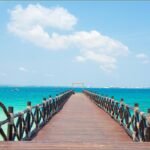Wondering when to go to Zanzibar without running into huge crowds or bad weather? Planning a trip to this stunning archipelago can feel overwhelming, especially with its unique blend of culture, beaches, and history. But fear not! The ideal time to visit Zanzibar often hinges on a mix of weather, your budget, local events, and your personal interests.
Let's break down all you need to know about choosing the best time for your adventure in paradise.
Overview of Zanzibar’s Climate
Zanzibar boasts a tropical climate, which means you can expect warm weather year-round. The island is categorized into two primary seasons: dry and wet.
-
Dry Season: Generally, this runs from June to October, with temperatures hovering between 24°C (75°F) and 32°C (90°F). During these months, you'll enjoy plenty of sunshine and lower humidity, making it perfect for beach days and outdoor activities.
- Wet Season: The long rainy season kicks in from March to May, with brief heavy showers; however, it often clears up quickly. The short rainy season occurs from November to early December. Temperatures in these months can hit 30°C (86°F) but might feel higher with increased humidity.
Understanding the weather in Zanzibar is critical for timing your visit right based on what you want to experience. Now, let's dig into the specifics month-by-month.
Month-by-Month Breakdown
January – February
- Weather: Warm and dry, with average temperatures around 29°C (84°F).
- Events: Mostly low-key, but there might be some local festivities.
- Pros: Ideal for sunbathing and beach activities.
- Cons: It can get quite hot, making midday activities challenging.
- Best For: Beach lovers and honeymooners enjoying quiet, beautiful shores.
March – April
- Weather: The start of the long rainy season, with humidity climbing. Showers are more common, but they usually don't last all day.
- Events: Various local traditions, with Swahili cultural celebrations.
- Pros: Fewer tourists leading to lower hotel prices.
- Cons: Wet weather and high humidity can make outdoor activities a bit tricky.
- Best For: Budget travelers who don't mind a little rain.
May
- Weather: This month can be quite rainy, with short heavy downpours.
- Events: Almost none, as many people opt to stay indoors.
- Pros: Low prices and fewer crowds.
- Cons: Heavy rains can limit outdoor activities, plus some hotels close.
- Best For: Deep budget travelers or those seeking solitude.
June – August
- Weather: Cool and dry, ideal for outdoor adventures. Temperatures typically range between 24-30°C (75-86°F).
- Events: This is a peak time for tourism, so expect more local events and activities.
- Pros: Great weather for diving, snorkeling, and exploring the islands.
- Cons: Higher prices for accommodations and crowded attractions.
- Best For: Families and tourists wanting a lively atmosphere.
September – October
- Weather: Still very dry, with festivals and ideal temperatures (around 28°C or 82°F).
- Events: Various cultural events, making it vibrant and lively.
- Pros: Perfect time for underwater activities and exploring the culture.
- Cons: Slightly more crowded as tourists flow in.
- Best For: Culture seekers and adventure lovers who want to experience vibrant local life.
November – Early December
- Weather: Transition into the short rainy season starts, so expect some scattered showers.
- Events: The annual Sauti za Busara music festival usually takes place in mid-February, but some pre-events can start in November.
- Pros: Fewer tourists as many avoid the incoming rains.
- Cons: Increased likelihood of rainy days.
- Best For: Travelers seeking to mix relaxation with cultural experiences on a budget.
Tips Based on Travel Style
For Budget Travelers
If you're looking to save some cash, aim for April through May. This is considered the lowest season due to the rainy weather, which means you can often snag fantastic deals on accommodations and flights.
For Avoiding Crowds
The rainy months of March to May are quieter but still offer opportunities for unique cultural experiences and exploring. If you can stand a bit of rain, you'll find fewer tourists and stunning coastal scenery to enjoy.
For Outdoor Activities or Cultural Events
Looking to dive into Zanzibar's rich culture or embrace outdoor adventures? June to October is your sweet spot for ideal weather, plus you'll get to partake in more festivals and local happenings.
For Romantic or Solo Trips
January and February provide a cozy atmosphere with fewer crowds on the beaches and stunning sunsets. Ideal for couples looking for a romantic getaway or solo travelers seeking peaceful escapes.
It really depends on what kind of experience you're looking for. Some travelers love January for the tranquil vibe, while others aim for the lively festivals in February.
Quick FAQ
Is April a good time to visit Zanzibar?
April can be quite rainy, but if you're looking for lower prices and few crowds, it can still be a good option.
When is the rainy season in Zanzibar?
The main rainy season is from March to May, with a shorter rainy period in November and early December.
What's the cheapest time to visit Zanzibar?
The rainy months, particularly April and May, generally offer the cheapest rates.
What's the peak season in Zanzibar?
June to October represents the peak tourist season due to pleasant weather and many events.
In the end, planning your trip to Zanzibar is about finding that balance between weather, availability, and the activities you want to enjoy. Whether you're after sun-soaked beaches or deep cultural experiences, there's a perfect time for you on this breathtaking island. Happy travels!








